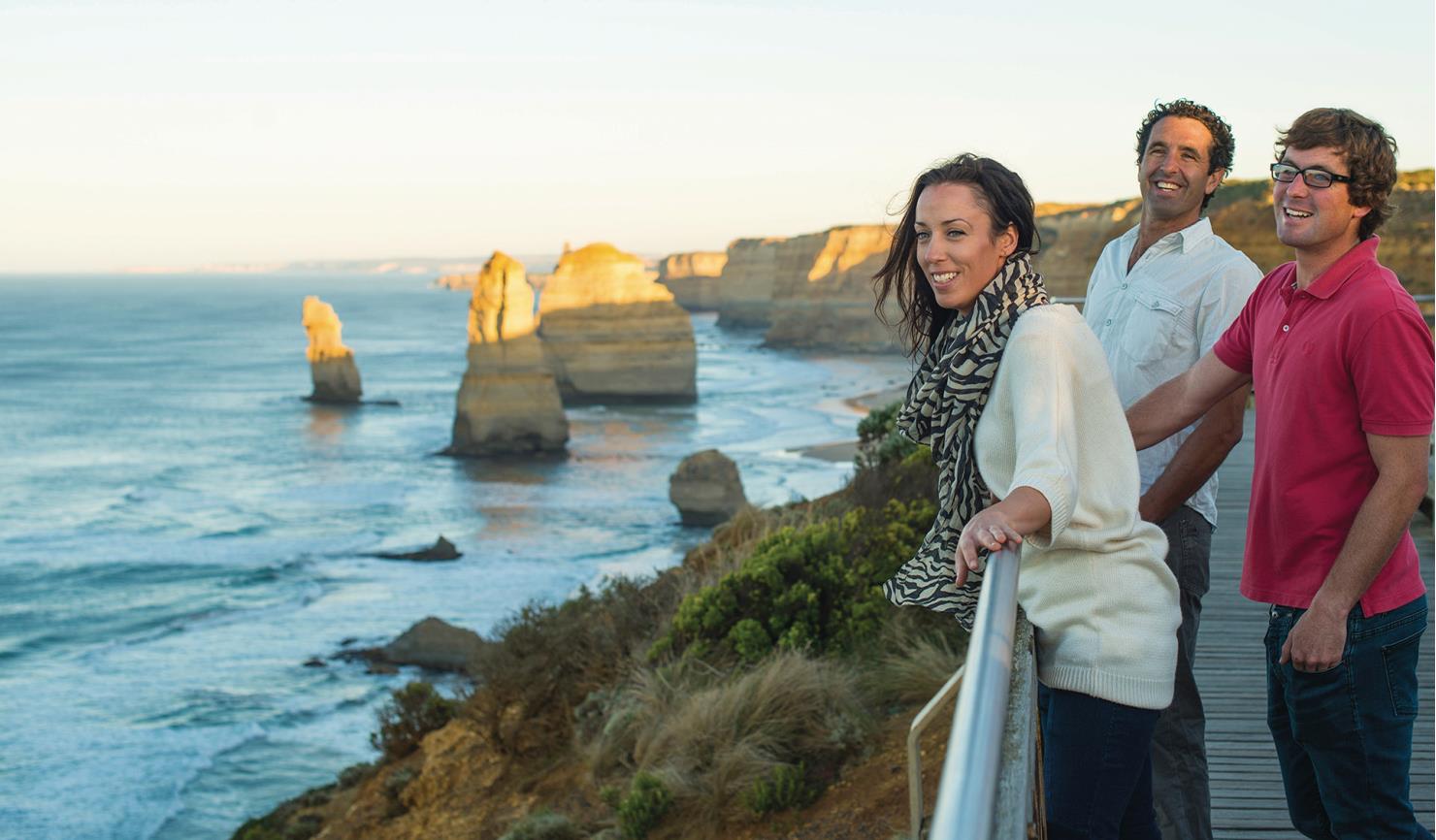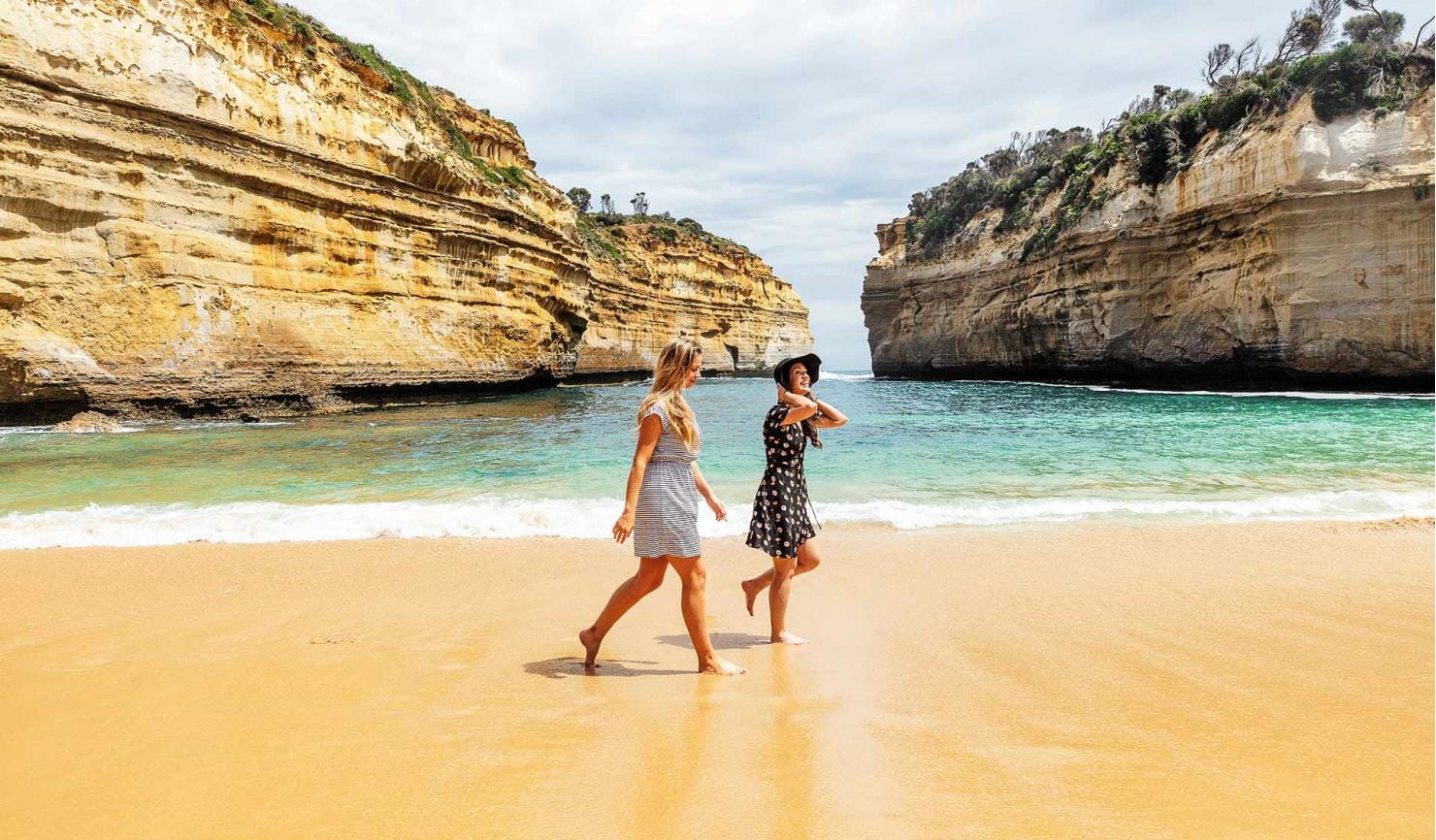Explore
Port Campbell National Park
The wild Southern Ocean has carved the Port Campbell National Park coastline into formations that are famous the world over - and earned it the nickname of the Shipwreck Coast. Drive the Great Ocean Road and see London Bridge, The Grotto, Loch Ard Gorge and the unmissable Twelve Apostles.
The best way to see Port Campbell National Park is to take the Great Ocean Road. This is one of the world's most celebrated scenic drives – and its undoubted highlight is the Twelve Apostles, which tower 45 metres above the Southern Ocean.
Other spectacular highlights along the Great Ocean Road include London Bridge and The Grotto, which are both awesome and impressively photo worthy.
Port Campbell National Park is also home to animals that carve out a niche on this inhospitable coastline. At dusk, they come home from their feeding grounds out at sea. Look down at the Twelve Apostles or London Bridge and you can see Little Penguins. Or check out the natural wonder of thousands of Short-tailed Shearwaters returning to roost on Muttonbird Island (near Loch Ard Gorge) at sunset. Whales are also a common sight along the coast and Port Campbell township is a good lookout to spot them from.
The Great Ocean Road Coast and Parks Authority (The Authority) has been appointed as manager for Port Campbell National Park, from 1 August 2024. The Authority will take over the responsibilities of Parks Victoria and ensure the Port Campbell National Park continues to thrive and be enjoyed by locals and visitors for generations to come. Parks Victoria staff will continue to be visible in the area, as they will maintain their role in monitoring and caring for the land during the transition period. For more information visit Great Ocean Road Coast & Parks Authority.
As beaches and coasts are natural environments, you may encounter hazards. Follow our water safety advice to make sure your day out at Port Campbell National Park is a safe and enjoyable one.
Top places
Tours and adventure experiences in parks
One of the best ways you can get into nature is with a Licensed Tour Operator.
There are more than 400 Licensed Tour Operators across Victoria who are ready and waiting to help you experience and connect with Victoria’s spectacular parks and waterways.
Discover more than 60 different types of nature-based experiences including hiking, mountain biking, boating, four-wheel driving, indigenous culture tours, birdwatching, surfing, diving and so much more.
Licensed Tour Operators know all the best places to go and will plan and prepare your visit to ensure you are safe and can enjoy your nature-based adventure to the fullest.
How to get there
Port Campbell National Park
Every evening between September and April, thousands of Short-tailed Shearwaters - a seabird - return to Mutton Bird Island to roost in burrows and feed their young. This is an astonishing natural event that every wildlife lover should witness.
From Loch Ard Gorge carpark, walk to the end of the Living on the Edge trail to Sherbrook Beach. It's not safe to swim here, but it's a beautiful and secluded place to linger for a while.
When you're there
When to go
Take a dip in Port Campbell Bay. The beach is patrolled during summer and it is the only safe place to swim along this stretch of coast.
Need to know
Port Campbell National Park
Accessibility
Visiting a park can be more of a challenge for people with disabilities, however in Victoria there are a wide range of facilities to help people of all abilities enjoy our wonderful parks around the state.
To make it easier for people with limited mobility to see the all abilities access and experiences on offer at Twelve Apostles and Loch Ard Gorge walks, Parks Victoria has released this video - produced and narrated by accessibility advocate Ryan Smith, who uses a wheelchair.
Two beach wheelchairs are available for visitor use at Port Campbell beach. These chairs are owned and managed by the Port Campbell Surf Lifesaving Club. Visit the Corangamite Shire website for further information and chair bookings.
Assistance dogs are welcome in Parks Victoria parks and reserves. Entry requirements apply for parks and reserves that are usually dog prohibited, such as national parks.
Tread lightly as the coast is fragile and your safety matters. Stick to marked trails to avoid injury, and to protect the delicate coastal vegetation and wildlife that call the park home.
Change of Conditions
Nature being nature, sometimes conditions can change at short notice. It’s a good idea to check this page ahead of your visit for any updates.
-
Notices Affecting Multiple Sites
Gibson Steps Beach Closure
Gibson Steps beach access has been temporarily closed due to recent geological movement.Geological assessments and remediation works have commenced. The site will reopen once the hazard has been removed and visitor safety is assured.Twelve Apostles Precinct- Change of Conditions Update Notice as of 20.10.2025
General Public InformationDue to ongoing construction works at the Twelve Apostles Visitor Centre, significant changes to access and parking arrangements will be in effect from Friday, 19th September 2025. All visitors are asked to plan ahead and be patient when travelling to the site during this busy period. High visitation is expected in-line with School and Public HolidaysKey changes and reminders for visitors include:- Temporary
Changes to Parking:
Construction works have resulted in temporary parking areas and altered traffic flow. Expect reduced speed limits, changed parking arrangements, and traffic management on-site. Please see attached map. - Car
Parking:
In the event of full parking capacity, visitors are encouraged to seek alternative destinations such as Port Campbell township or Bay of Islands, and encouraged to return later in the day. - Pedestrian
Safety:
Use designated walkways and pedestrian crossings only. Do not climb fences or viewing barriers. - Environmental
Care:
Protect this unique landscape by staying on paths, respecting barriers, and taking your rubbish with you. - Bushfire
Safety:
Stay informed by visiting emergency.vic.gov.au, downloading the VicEmergency app, or calling the VicEmergency Hotline on 1800 226 226.
For more information, contact Parks Victoria on 13 1963 or visit parks.vic.gov.au
Licensed Tour Operators (LTOs)
IMPORTANT – Operational and Access UpdateFrom Friday, 19th September 2025, the following updates apply to all Licensed Tour Operators visiting the Twelve Apostles:New Access & Parking Procedures:- Coach/Bus/Coaster
Access:
All LTO vehicles must access the temporary parking area via Booringa Road and the new entry/exit road. Directional signage will be in place. Please see attached map. - Temporary
Parking Area:
Use designated bays only. This area has been established during current construction works. - Drop-Off
Instructions:
- All
vehicles (with or without trailers) must drop passengers
at the front of the Visitor Centre.
- Pick-ups
are not permitted at the drop-off zone.
- Drivers
must proceed immediately to the designated parking area
after drop-off.
- Provide
passengers with clear directions and walking instructions before they
disembark.
Traffic Management:- Follow
Traffic Controller Instructions at all times when management is
in place.
- Be
prepared for redirection to alternative parking areas based on
capacity.
- Observe
on-site signage directing different vehicle sizes to specific parking
bays.
Operational Reminders:- Permit
Display: Ensure your LTO permit is clearly displayed on
your vehicle at all times.
- Passenger
Safety: Remind passengers to use designated walkways and not to climb
fences or barriers.
- Journey
Planning: Allow extra time, travel safely, and prepare staff for
delays due to high visitation and traffic coordination.
Stay Informed:- Further
updates and staging plans are available at the Development Victoria
website:
www.development.vic.gov.au/projects/twelve-apostles?page=resources
Thank you for your cooperation in maintaining a safe and enjoyable experience for all visitors while works are underway. Your support is essential in protecting the Twelve Apostles and surrounding areas.Attachments: LTO Map Updated 17.10.25 Conditions A3 (98KB)
- Temporary
Changes to Parking:
-
The Arch Day Visitor Area (Port Campbell National Park)
The Arch - Closed for public safety - Geotechnical risks
The Arch lookout is closed due to significant geotechnical risks affecting public safety. No re-open date is planned for the foreseeable future. -
Loch Ard Gorge (Port Campbell National Park)
Loch Ard Gorge Beach Access Steps Closed
Loch Ard Gorge beach access steps are currently closed due to geological instability. The site will remain closed until remediation works are completed to remove the hazards and ensure visitor safety.
How we keep it special
The Port Campbell National Park and Bay of Islands Coastal Park Management Plan directs aspects of management across the park.
The Great Otway Parks Conservation Action Plan provides directions for environmental conservation management across the diverse landscape, including Port Campbell National Park. This covers the old-growth forests, cool temperate rainforests and wet forest, heathlands, coastline and marine ecosystems.
Saddle Lookout
A key project in Stage One of the Shipwreck Coast Master Plan is developing the ‘Saddle Lookout’ at the Twelve Apostles visitor precinct. The new lookout will replace existing viewing areas that no longer cater for visitor numbers, providing a superior, safer and more accessible experience. Learn more about the Saddle Lookout project.
Blowhole Lookout
A new lookout is being created at Loch Ard Gorge, providing new views of ‘The Blowhole’ – a deep cutting in the land that fills with rushing water when tides are high. Learn more about the Blowhole Lookout project.





